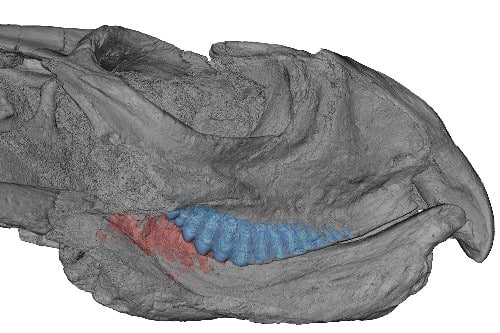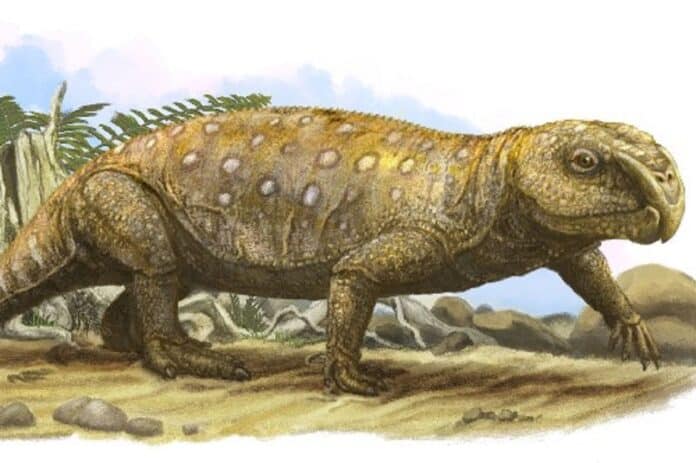Rhynchosaurs played an important role as herbivores during the Middle and Late Triassic because of their unique ankylothecodont style of tooth implantation. The primary area of oral food processing grew posteriorly with the upwardly curving anterior jaw points.
A team of University of Bristol academics has shed light on the existence of the prehistoric reptile Rhynchosaur, which walked the Earth between 250 and 225 million years ago.
Rhynchosaurs are a little-known group of ancient reptiles that lived during the Triassic Period when the environment was generally warm and the flora was harsh.
They examined Devon specimens using CT scanning to see how the teeth wore down as the animals feasted and how new teeth were introduced at the backs of the tooth rows as the creatures grew.

The findings, published today in Palaeontology, indicate that these early herbivores likely died of starvation in old age, with the plants wearing down their teeth.
Team leader Professor Mike Benton from Bristol’s School of Earth Sciences said, “I first studied the rhynchosaurs years ago. I was amazed to find that they dominated their ecosystems in many cases. If you found one fossil, you found hundreds.”
He said, “They were the sheep or antelopes of their day, and yet they had specialized dental systems adapted for dealing with masses of tough plant food.”
Dr. Rob Coram, who discovered the Devon fossils, said: “The fossils are rare, but occasionally individuals were entombed during river floods. This has made it possible to put together a series of jaw bones of rhynchosaurs that ranged in age from quite young, maybe even babies, through adults, and including one particularly old animal, a Triassic old-timer whose teeth had worn right down and probably struggled to get enough nutrition each day.”
Thitiwoot Sethapanichsakul, who studied the jaws as part of his MSc in Palaeobiology, said, “Comparing the sequence of fossils through their lifetime, we could see that as the animals aged, the area of the jaws underwear at any time moved backward relative to the front of the skull, bringing new teeth and new bone into wear, They were eating tough food such as ferns, that wore the teeth down to the bone of the jaw, meaning that they were chopping their meals by a mix of teeth and bone.”
Dr. Coram added, “Eventually, though, after a certain age, we’re not sure quite how many years their growth slowed down, and the area of wear was fixed and just got deeper and deeper; it’s like elephants today they have a fixed number of teeth that come into use from the back, and after the age of seventy or so they’re on their last tooth, and then that’s that.”
He said, “We don’t think the rhynchosaurs lived that long, but their plant food was so testing that their jaws simply wore out, and presumably, they eventually starved to death.”
The rhynchosaurs were an essential part of the land ecosystems throughout the Triassic Period when life was recovering from the world’s largest mass extinction at the end of the preceding Permian Period.
When dinosaurs, and subsequently mammals, became dominant as the modern world was slowly being built, these species were part of the recovery. They set the stage for new forms of ecologies. They helped to pave the way for new kinds of ecologies. The team demonstrated how rhynchosaurs’ dentitions changed over time.
Their distinctive teeth allowed them to diversify twice, first in the Middle Triassic and then in the Late Triassic. They did this by comparing samples of older rhynchosaurs with later-occurring species from Scotland and Argentina.
Rhynchosaurs died out, but climate change and changes in the available plants allowed dinosaurs to take control.
The conclusion shows that the tooth-bearing components of the Middle Triassic rhynchosaur Bentonyx Sinensis have undergone CT scans consistent with earlier investigations of their unusual dentition. Their ankylothecodont implantation differs from acridity in that it does not rest in persistent sockets or a dental groove.
Journal Reference:
- Sethapanichsakul, T., Coram, etal. The unique dentition of rhynchosaurs and their two-phase success as herbivores in the Triassic. Journal of Paleontology. DOI: 10.1111/pala.12654
